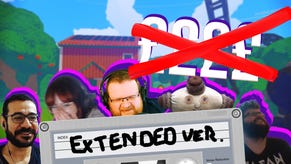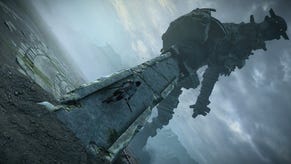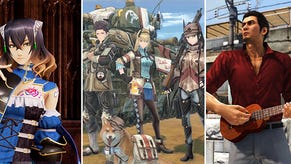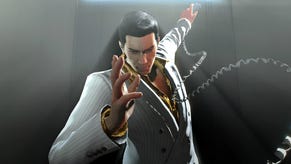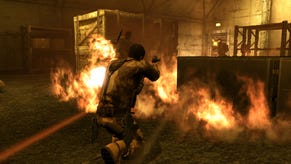Inside Yakuza 6's In-Depth Localization
With two Yakuza games now under their belt, Sega's localization team is going above and beyond for Yakuza 6.
This article first appeared on USgamer, a partner publication of VG247. Some content, such as this article, has been migrated to VG247 for posterity after USgamer's closure - but it has not been edited or further vetted by the VG247 team.
There's a moment in the early goings of Yakuza 0 where you're playing as Goro Majima, the second playable protagonist of the game. He resides far away from the game's other hero, the Tokyo-based Kiryu Kazuma, in S?tenbori, Osaka. Yakuza 0 is a prequel to the Japan-based, crime series of Yakuza, set in the year 1988. The game goes to pains to immerse the player in this era—from its more intricate environment details to the retro arcade games you can play—and then there were moments that took you out of it.
Such as when Majima says "shitballs."
This was the first game helmed by Sega's current localization team on the series. Yakuza 5, and the much earlier predecessors, were under a different reign. Localization is a hotly contentious topic in the realm of video games. Persona 5 and Ys 8: Lacrimosa of Dana were controversial for their rougher localizations. For the former, clunky sentences were the worst offender, with some players blaming it on it being closer to a "translation" rather than a "localization" (the distinction being the latter molds the original language's intent to English). On the other hand, Ys 8 got a whole new localization, including updated voice acting after outcry. With the matter of Yakuza 0, there wasn't widespread unrest, only gentle jabs towards its era-confused dialogue.
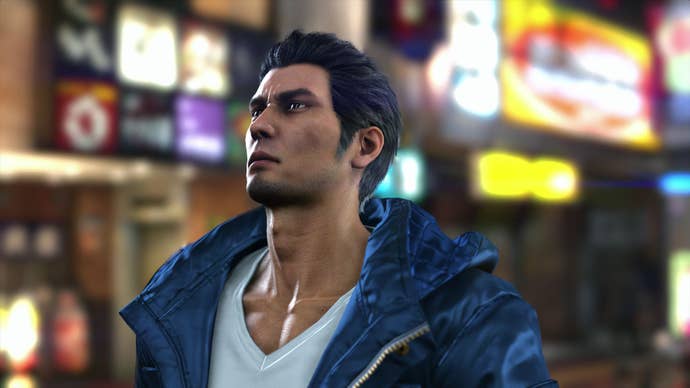
The part-brawler, part-semi-open world game was still a hit across social media, with sales of it driven heavily by word of mouth and streaming. This was all in spite of the localization itself being littered with scene-breaking moments like Majima saying "shitballs." It wasn't clunky sentences that marred the experience though, it was that it didn't feel like the game was adapted for the year 1988, but instead for our current time; like an old fan-dub of an anime with ad-libbed swear words for edginess. Yakuza 6: The Song of Life, the upcoming (and most recent) game in the Yakuza series, is propped to succeed to even greater heights though, unshackled by the chains of writing for an older period of time. The game is set in a more modern, familiar era: 2016, with an aging Kiryu at the center of it all.
Currently in Yakuza 6, I'm mulling about Onomichi, Hiroshima, a port town in Japan. There's cats around that I can feed and recruit to my cat cafe; a mascot I can masquerade as for a quest or so. There are vending machines that I can buy drinks from. I'm not me though, I'm Kiryu Kazuma from Yakuza 6, a long-feared but kind-hearted individual in society, and his journey is almost through.
Yakuza 6 is stuffed with even more silly side quests—coupled with a more serious main quest—as ever before; this dichotomy is what made so many players fall in love with the series for the first time last year with Yakuza 0. As I'm playing bits and pieces of Yakuza 6, I'm guided by Localization Producer Scott Strichart. His team started helming the localization for the Yakuza series around Yakuza 0, and since then, they've come into their own. They're no longer held back by the throwback eras of Yakuza 0 and Yakuza Kiwami, so now the team is able to let loose with the 2016-set Yakuza 6: the most modern game in the series so far. Hell, there's even a quest about a Siri-like feature going horribly, horribly wrong. There's no out of place lingo to stumble into in this game. At least not yet.
"We internally consider [Yakuza 0 as] a reboot," Strichart says. "As we have been rolling our localizations, we've been improving our own styles and strategies and really refining what we wanted to do." There are plenty of things, he notes, that players won't really notice. From improved line breaks to contextual information on the loading screen to help explain the more Japan-centric quirks that might go over Western players' heads, Yakuza 6 is Strichart's localization team cracking their knuckles to break out the most intricate changes—even if the audience may not even notice the particulars.
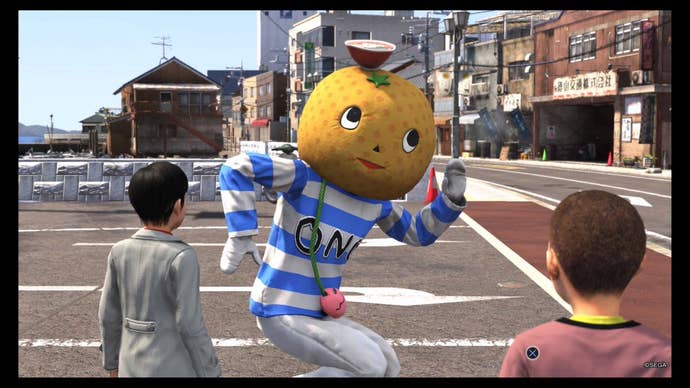
One of these smaller details is excitedly pointed out to me as I'm walking around Onomichi. I was on my way down to a canal, when I'm directed to visit a stone that looks something like a shrine; it's tall and gray, from what I remember. I hit a button to interact with it, and dramatically words appear large on my screen. Japanese characters are the most prominent here, with a shadow beneath them and, most importantly, the English version laid over it. Visually, this looks even more dramatic and impactful than its Japanese equivalent. Kiryu reads this aloud in his signature deep, serious voice. These are poems, I'm told, and retrofitting them to the Western world's edition of Yakuza 6 required a lot of back and forth with the Yakuza team in Japan to get it just right.
Over email after our meeting, a Sega representative sent over an example of one of these poems at my request, comparing how it would be if it were directly translated to the final localized version of it.
Translation:
A pine tree is snuggling to a huge rock as if it tries to harness it. The sparkling light is the reflection from the sea breaking through the pine trees.
I have returned to Senkoji for the first time in six years where the crystal-clear beauty of nature is within hand's reach.
In time, night begins to cast its shadow on the roof tiles, and the sails of distant boats cast diagonal shadows.
But the sake we're sharing remains unfinished.
To commemorate the regretfulness, I would like to request something to you young fellows.
Please remember this place as a place where I enjoyed the sake and the view of it.
Final Localization:
Around a weather-worn boulder, the nimble pine coils.
As light meets the sea, the forest leaves glow.
After six long years, I have returned to Senkoji.
Within arm's reach, lies the harmony of nature.
Soon night casts its gentle shadow, and distant ships fade.
And yet, the sake we share remains unfinished.
To honor my anguish, of youth, I ask a favor.
Enshrine this site, and its poignant display.
— Rai Sanyo
"When localizing something like a poem, the result is subjective. Poetry by nature is dependent on the reader's interpretation of the speaker, so when the localizer must interpret the speaker of a poem, like in Yakuza 6: The Song of Life, we consider elements like intent, rhythm and meter as it was meant in the original language," writes Senior Localization Producer Sam Mullen over email. "For this poem, a direct translation might be more accurate in word, but off in other aspects of poetry when translated into English. The final version represented here is actually closer to the ebb, rhythm, and flow of the Japanese. Japanese poems like to pack a lot of imagery into small clips of words, but the translation captures all of that and makes it explicit. Basically, if you are localizing, you unpack the Japanese and lay it all out in front of you, consider each bit, and pack it all back up in a totally different fashion that still feels poetic."
Localizing poems are only one example of the lengths Yakuza 6's localization crew went to in adding an extra bit of flavor to the game for Western audiences. "We also had to put a lot more effort into this game in general just because it's completely voiced. Not to say that we didn't put effort into the previous ones but there's a lot more required of the finessing of a game that is completely voiced," says Strichart. In the last few Yakuza games, side stories were not voice acted aside from grunts and other noises to indicate changes of feeling. In Yakuza 6, everything is voice acted, all the time. "You have to listen to the voice you have to make sure your [subtitles] are running appropriately to that voice."
That approach comes in timing dialogue. Before, dialogue rolled out at a slower pace, because the player was at the control of it, ushering it forward or stopping at their leisure. In Yakuza 6, while that control of skipping through dialogue remains, players can also kick back and listen to it play out in motion while reading the English captions in real-time. In a way, the new system has quite a lot in common with foreign films' approach to subtitling.

Overall, with two sizable recent hits of the Yakuza series under their belt now (after Yakuza 0's widespread adoration on social media, especially), the localization team at Sega had a belly full of confidence this time around. That power is not going unwasted either: the team's bent towards making Yakuza 6 the most accessible game in the series to date, whether that's in peppering in contextual descriptions for Japan in loading screens, writing "less wordy" tutorials, or just adding context for the many relationships of the characters that players may not know of if it's their first game in the series. They want no player to feel lost in Yakuza 6, unless it's lost in a good way.
To prep players for the journey, Strichart and co-producer Sam Mullen have been hosting weekly in-depth streams diving into the localization for Yakuza 6. From the tribulations of teaching players how to play Mahjong, to the dense character backgrounds, the duo are giving an inside look at the game long before its impending worldwide release. After all, the Yakuza series is one that places its characters at its center. And as Strichart tells me, as a self-defined "character guy," writing for Yakuza's layered characters is where the localization gets a chance to shine the most.
As for Yakuza 6 itself, it's the first game in the series not held back by the last generation PlayStation 3, as it's on a new engine exclusive for PlayStation 4. The new engine's improvements are evident all around the two explorable areas of the relaxing Onomichi and the much busier Kamurocho. With an updated engine, the same goofy and dramatic tales the series is known for, and a more robust localization at its behest, Kiryu's final adventure will be one to behold. The game releases on April 17, 2018 for PlayStation 4. For help with the game, check out our Yakuza 6 guide.



